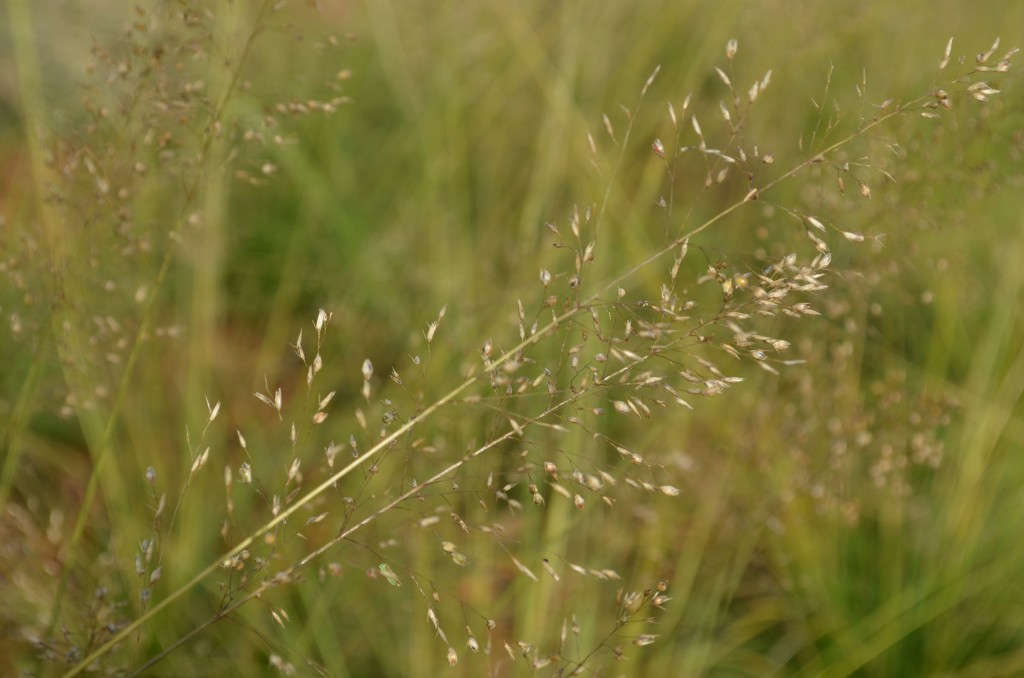Native Grass & Sedges
Grasses and sedges are often overlooked in garden planning but they make a wonderful addition to any garden because aesthetically, they provide great texture, color, and height to gardens in every season. In addition to adding beauty to your landscape, native grass and sedges provide resources to a wide variety of birds, insects, and even mammals all year long.
Grass or Sedge? How can I tell?
Have you ever wondered about the difference between grasses and sedges? I remember learning the phrase “sedges have edges” in my very first botany class. The mnemonic was meant to help us remember that rather than being round, sedge stems have distinct edges. While here at Lewis Ginter Botanical Garden, I learned the rest of the poem:
Sedges have edges,
Rushes are round,
Grasses have nodes from the top to the ground.
Grasses do not have edges on their stems and are mostly hollow except for the nodes which are small sections of the stem that help hold the plant together.
Here are a few native kinds of grasses and sedges you will see while visiting Lewis Ginter Botanical Garden.
Little Bluestem
Schizachyrium scoparium, also called little bluestem, is an ornamental bunch grass that gets its name from its bluish stems. These blue stems turn red-brown in the fall and remain that color throughout winter. So you have nearly a rainbow of color from just one plant!
“You can’t beat the vivid blue this grass brings to the spring garden,” says Senior Horticulturist Elizabeth Fogel who has been incorporating native grasses and sedges into the plantings around Sydnor Lake. In addition to providing color to your garden even in the winter, this grass is very useful to birds and insects. It provides valuable nesting material for bees and its seeds provide food to songbirds and small mammals. For those who love to watch butterflies, this grass has a trick up its sleeve. Did you know that grass can also act as host species for caterpillars? It’s true! Little bluestem is a host for the ottoe skipper, Indian skipper, crossline skipper, Leonard’s skipper, and cobweb butterfly. You can see Schizachyrium scoparium in the Morton Native Plant Garden and along the lake edge near the Children’s Garden.
Appalachian Sedge
Appalachian sedge, or Carex appalachica, is a perennial sedge that grows in small 12 inch green tufts. Carex appalachica is well-loved for its adaptability and its ability to grow in a wide range of conditions – including the shade. Like most sedges, the Appalachian sedge provides great cover for insects. Its tiny flowers aren’t showy, but provide nectar to insects and seeds for native birds. “I love the addition of this small, graceful sedge to many types of gardens,” says Fogel. “It can serve as an edger along the front of a formal bed, or fill in gaps between taller plants throughout a more natural garden.” You can see this sedge along Lake Sydnor where it helps prevent erosion and provides weed control by acting as a ground cover under taller plants.
Prairie Dropseed

Prairie dropseed (Sporobolus heterolepis) is a fine-textured ornamental bunchgrass perfect for smaller gardens.
Prairie dropseed (Sporobolus heterolepis) is a fine-textured ornamental bunchgrass that can be found at Lewis Ginter Botanical Garden outside of the Conservatory and on the banks of Sydnor Lake. “The maximum height of 2-3 feet of prairie dropseed makes it an excellent grass for smaller gardens,” says Fogel. Bright green for the spring and summer, it turns golden orange in the fall before fading to bronze for the winter. Delicate clusters of small, fluffy pink flowers grace the late summer garden. So four seasons of color, from just grass! Plus, many species of beneficial insects and birds use this grass for food and shelter. Like many kinds of grass, prairie dropseed has a fibrous root system, meaning it helps to prevent erosion by firmly anchoring the plant into the ground while holding the surrounding topsoil in place.
Pennsylvania Sedge
Carex pensylvanica or Pennsylvania sedge is a perennial sedge closely related to Appalachian sedge. Both grow in small green tufts and prefer part to full shade. In fact, this sedge does very well under large trees. If you’ve ever wanted to see large wild birds, Carex pensylvanica is a plant to look out for because in addition to the Eastern Towee and several species of sparrow, the seeds from this sedge are a favorite of the greater prairie chicken, wild turkey, and ruffed grouse! You can check out Pennsylvania sedge at Lewis Ginter Botanical Garden – near its close relative, Appalachian sedge – along Lake Sydnor as it works to prevent erosion of the lake edge and outcompete weeds.
Overwintering
I know a lot of gardeners are eager to cut back plants at the beginning of winter, but this year, consider leaving your native grasses and sedges long during the winter months. Many insects use a process called “overwintering,” which is similar to hibernation to survive the cold winter months. By waiting until the end of winter to cut back your native grasses, you not only lighten your own workload but also help maintain a healthy insect population in your garden. Birds will appreciate the additional winter shelter too.
Native sedges and grasses are amazing, multi-functional plants. They provide great texture, a rainbow of color, and variety in height to any garden or landscape while also holding the topsoil to prevent erosion. Native grass and sedges provide much-needed habitat and act as a food source for a wide variety of birds, insects and other wildlife. These sedges and native grass can add a wonderful boost to your home landscape or garden.
